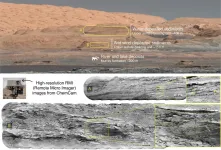(Press-News.org) Two studies published in the open-access journal PLOS Pathogens provide new evidence supporting an important role for the immune system in shaping the evolution of SARS-CoV-2, the virus that causes COVID-19. These findings--and the novel technology behind them--improve understanding of how new SARS-CoV-2 strains arise, which could help guide treatment and vaccination efforts.
For the first study, Rachel Eguia of Fred Hutchinson Cancer Research Center in Seattle, Washington, and colleagues sought to better understand SARS-CoV-2 by investigating a closely related virus that has circulated widely for a far longer period of time: the common-cold virus 229E.
229E and SARS-CoV-2 are both in the coronavirus family, which features a "spike protein" that enables infection of human cells. A person who is infected with 229E develops an immune response against the spike protein that protects them from reinfection, but only for a few years. Whether reinfection then occurs because the immune response wears off or because 229E evolves to escape it has been unclear.
Eguia and colleagues addressed this question by testing the activity of serum samples collected from patients in the 1980s-90s against spike proteins from both old 229E strains and strains that evolved later on. They found that the old spike proteins were vulnerable to the older sera. However, modern spike proteins were able to evade older sera while remaining vulnerable to sera from modern patients.
This analysis suggests that modern strains of 229E have accumulated spike protein mutations that enable them to evade older sera. These findings raise the possibility that SARS-CoV-2 and other coronaviruses could undergo similar evolution, and that COVID-19 vaccines may require periodic updates to remain effective against new strains.
The authors add, "The human common-cold coronavirus evolves over the span of years to decades to erode neutralization by human polyclonal serum antibodies. This work suggests that human coronaviruses undergo significant antigenic evolution that may contribute to eventual re-infections."
For the second study, Sung Hee Ko of the National Institute of Allergy and Infectious Diseases in Bethesda, Maryland, and colleagues developed new technology for genetic sequencing of the SARS-CoV-2 spike protein, enabling detection of multiple SARS-CoV-2 strains that may be present at the same time within a single infected patient.
Previous studies have used standard sequencing methods to produce a single genetic sequence from an individual patient, obscuring the potential presence of multiple SARS-CoV-2 strains. By contrast, the new technology highlights virus diversity within each patient and enables tracking of the evolution of new SARS-CoV-2 strains during acute infection.
Indeed, when the researchers applied the new method to human respiratory samples, they found new SARS-CoV-2 variants arising within the same patient over the course of acute infection. The precise mutations in these variants suggest that they arose in response to selective pressure from the immune system.
Future application of the new technology could improve understanding of how the evolution of new SARS-CoV-2 variants within a single patient impacts their outcomes. The findings also suggest that patients might see greater benefits from early treatment with antiviral drugs capable of targeting multiple strains, than from delayed treatment with a single antiviral drug.
The authors add, "We used new technology to show that coronavirus variants with mutated spike proteins can arise early in the course of infection. Our results suggest more virus evolution in each person than previously thought, with potential implications for clinical outcomes and for the emergence of transmissible variant strains."
Together, these two studies deepen understanding of how new SARS-CoV-2 strains arise in response to immune system activity, potentially paving the way for additional research and improved treatment.
INFORMATION:
Peer-reviewed; Experimental study; People; Cells
In your coverage, please use these URLs to provide access to the freely available articles in PLOS Pathogens: http://journals.plos.org/plospathogens/article?id=10.1371/journal.ppat.1009431 http://journals.plos.org/plospathogens/article?id=10.1371/journal.ppat.1009453
Citation (Paper 1): Ko SH, Bayat Mokhtari E, Mudvari P, Stein S, Stringham CD, Wagner D, et al. (2021) High-throughput, single-copy sequencing reveals SARS-CoV-2 spike variants coincident with mounting humoral immunity during acute COVID-19. PLoS Pathog 17(4): e1009431. https://doi.org/10.1371/journal.ppat.1009431
Citation (Paper 2): Eguia RT, Crawford KHD, Stevens-Ayers T, Kelnhofer-Millevolte L, Greninger AL, Englund JA, et al. (2021) A human coronavirus evolves antigenically to escape antibody immunity. PLoS Pathog 17(4): e1009453. https://doi.org/10.1371/journal.ppat.1009453
Funding (Paper 1): Funding was provided by the Intramural Research Program of the U.S. National Institutes of Health (project AI005157-01, E.A.B). M.J.R-B. is supported by NIGMS Postdoctoral Research Associate Training Program (1FI2GM137804-01). The funders had no role in study design, data collection and analysis, decision to publish, or preparation of the manuscript.
Funding (Paper 2): This work was supported by the following grants from the National Institute of Allergy and Infectious Disease of the National Institutes of Health (https://www.niaid.nih.gov/): R01AI127893 (to JDB), R01AI141707 (to JDB), F30AI149928 (to KDC). JDB is an Investigator of the Howard Hughes Medical Institute (HHMI, https://www.hhmi.org/). The funders had no role in study design, data collection and analysis, decision to publish, or preparation of the manuscript.
Competing Interests (Paper 1): The authors declare no competing interests.
Competing Interests (Paper 2): I have read the journal's policy and the authors of this manuscript have the following competing interests: MJB has consulted for Moderna and Vir Biotechnologies, and received research funding from Regeneron and Vir Biotechnologies. JAE has consulted for Meissa Vaccines and Sanofi Pasteur, and received research funding from Merck, GlaxoSmithKline, Pfizer, and AstraZeneca. The other authors declare no competing interests.
A group led by scientists from the RIKEN Cluster for Pioneering Research, using coordinated observations of the Crab pulsar in a number of frequencies, have discovered that the "giant radio pulses" which it emits include an increase in x-ray emissions in addition to the radio and visible light emissions that had been previously observed. This finding, published in Science, implies that these pulses are hundreds of times more energetic than previously believed and could provide insights into the mysterious phenomenon of "fast radio bursts (FRBs)."
Giant radio pulses--a phenomenon where extremely short, millisecond-duration pulses of radio waves are emitted--have ...
Researchers at the Francis Crick Institute have found that blocking a specific protein could increase tumour sensitivity to treatment with PARP inhibitors. Their work published in Science , suggests combining treatments could lead to improved therapy for patients with inheritable breast cancers.
Some cancers, including certain breast, ovarian and prostate tumours, are caused by a fault in the BRCA1 or BRCA2 genes, which are important for DNA repair. Treatment for these cancers has greatly improved thanks to the discovery of PARP inhibitors, drugs which capitalise on this weakness in the cancer ...
Scientists at the Victor Chang Cardiac Research Institute in Sydney have discovered a critical new gene that it is hoped could help human hearts repair damaged heart muscle after a heart attack.
Researchers have identified a genetic switch in zebrafish that turns on cells allowing them to divide and multiply after a heart attack, resulting in the complete regeneration and healing of damaged heart muscle in these fish.
It's already known that zebrafish can heal their own hearts, but how they performed this incredible feat remained unknown, until now. In research recently published in the prestigious journal, Science, the team at the Institute drilled down into a critical ...
Modern humans are fundamentally different from our closest living relatives, the great apes: We live on the ground, walk on two legs and have much larger brains. The first populations of the genus Homo emerged in Africa about 2.5 million years ago. They already walked upright, but their brains were only about half the size of today's humans. These earliest Homo populations in Africa had primitive ape-like brains - just like their extinct ancestors, the australopithecines. So when and where did the typical human brain evolve?
CT comparisons of skulls reveal modern brain structures
An international ...
Researchers have developed a new algorithm capable of identifying features of male zebra finch songs that may underlie the distinction between a short phrase sung during courtship, and the same phrase sung in a non-courtship context. Sarah Woolley of McGill University in Montreal, Canada, and colleagues present these findings in the open-access journal PLOS Computational Biology.
Like many animals, male zebra finches adjust their vocal signals for their audience. They may sing the same sequence of syllables during courtship interactions with females as ...
DALLAS - April 8, 2021 - New research has uncovered a surprising role for so-called "jumping" genes that are a source of genetic mutations responsible for a number of human diseases. In the new study from Children's Medical Center Research Institute at UT Southwestern (CRI), scientists made the unexpected discovery that these DNA sequences, also known as transposons, can protect against certain blood cancers.
These findings, published in Nature Genetics, led scientists to identify a new biomarker that could help predict how patients will respond to cancer therapies and find new therapeutic targets for acute myeloid leukemia (AML), the deadliest type of blood cancer in adults and children.
Transposons ...
Every third-grader knows that plants absorb nutrients from the soil through their roots. The fact that they also release substances into the soil is probably less well known. And this seems to make the lives of plants a lot easier.
That is at least the conclusion of the current study. The participating researchers studied several maize varieties that differ significantly in their yield. In their search for the cause, they came across an enzyme, flavone synthase 2. "The high-yield inbred line 787 we studied contains large amounts of this enzyme in its roots", explains Dr. Peng Yu ...
A global science collaboration using data from NASA's Neutron star Interior Composition Explorer (NICER) telescope on the International Space Station has discovered X-ray surges accompanying radio bursts from the pulsar in the Crab Nebula. The finding shows that these bursts, called giant radio pulses, release far more energy than previously suspected.
A pulsar is a type of rapidly spinning neutron star, the crushed, city-sized core of a star that exploded as a supernova. A young, isolated neutron star can spin dozens of times each second, and its whirling magnetic ...
SALT LAKE CITY - A letter published today by Huntsman Cancer Institute (HCI) at the University of Utah (U of U) in the New England Journal of Medicine reports that melanoma mortality among Utahns outpaced that of the rest of the United States during the period from 1975 to 2013. Melanoma death rates have been decreasing in recent years both in Utah and the United States, a trend likely attributable to new, more effective treatments, like immunotherapy. However, melanoma remains the deadliest type of skin cancer, and the incidence of melanoma diagnoses in Utahns is higher than in any other ...
LOS ALAMOS, N.M., April 8, 2021-While attention has been focused on the Perseverance rover that landed on Mars last month, its predecessor Curiosity continues to explore the base of Mount Sharp on the red planet and is still making discoveries. Research published today in the journal Geology shows that Mars had drier and wetter eras before drying up completely about 3 billion years ago.
"A primary goal of the Curiosity mission was to study the transition between the habitable environment of the past, to the dry and cold climate that Mars has now. These rock layers recorded that change in great detail," said Roger Wiens, a coauthor on the paper and scientist at Los Alamos National Laboratory, ...







